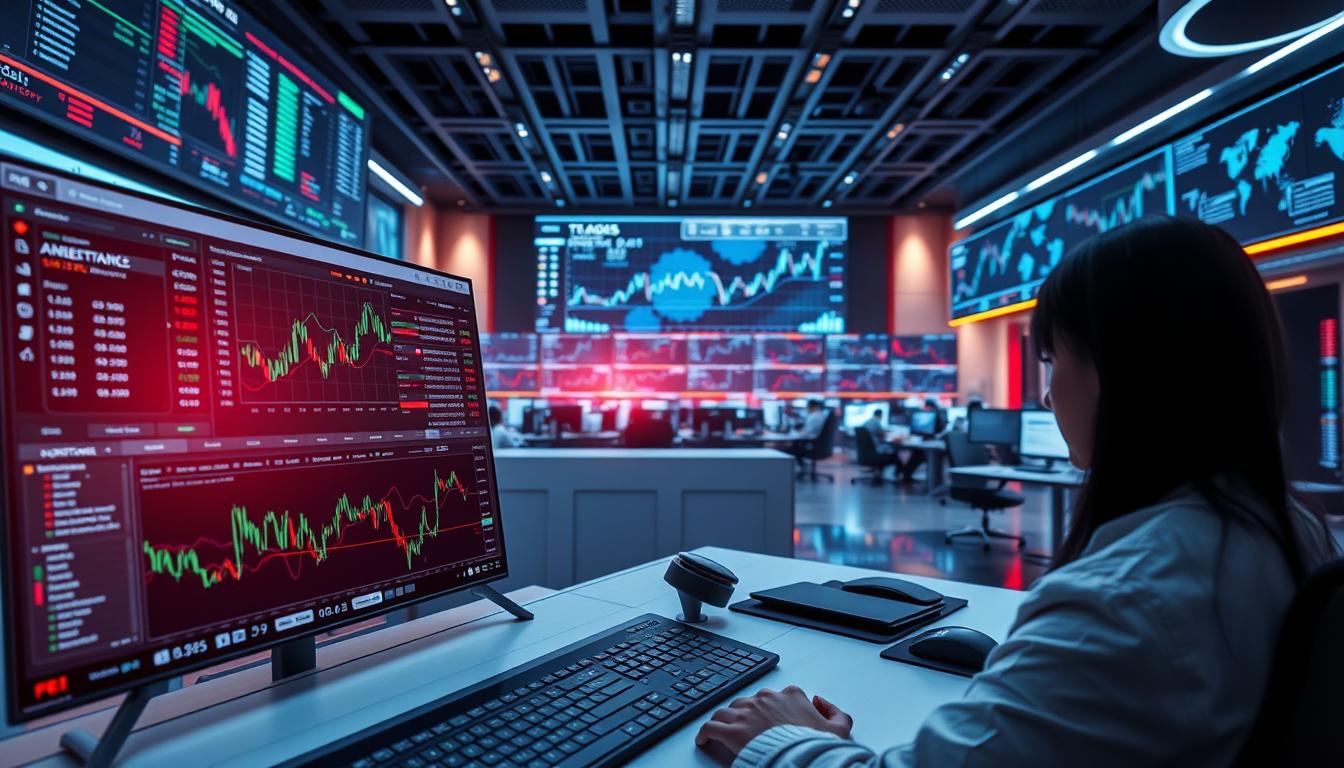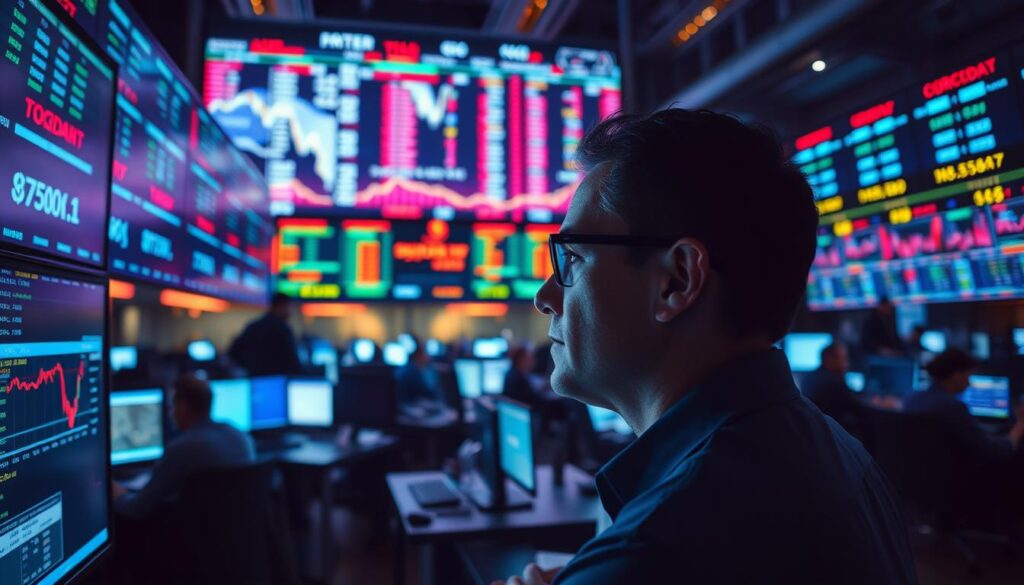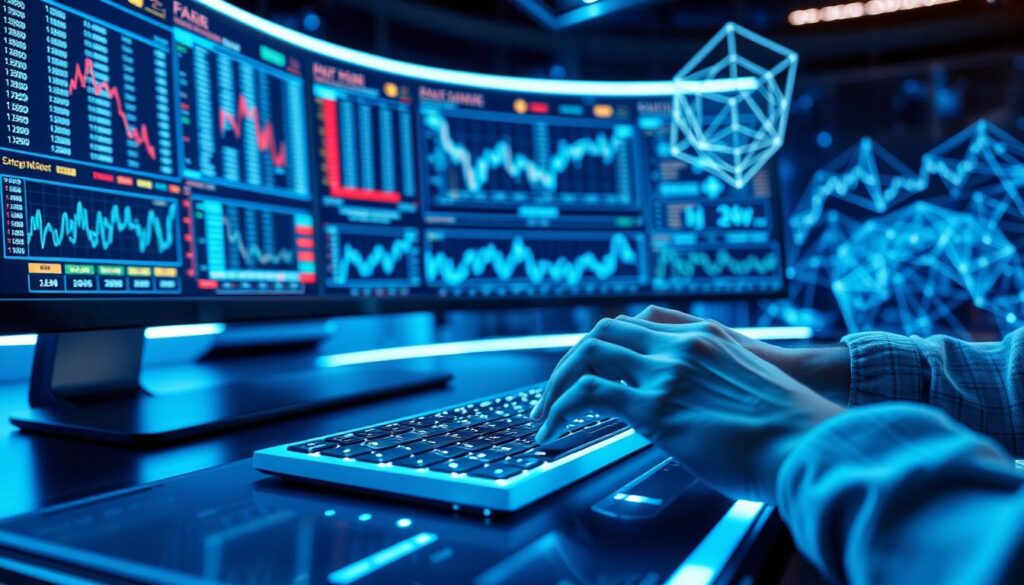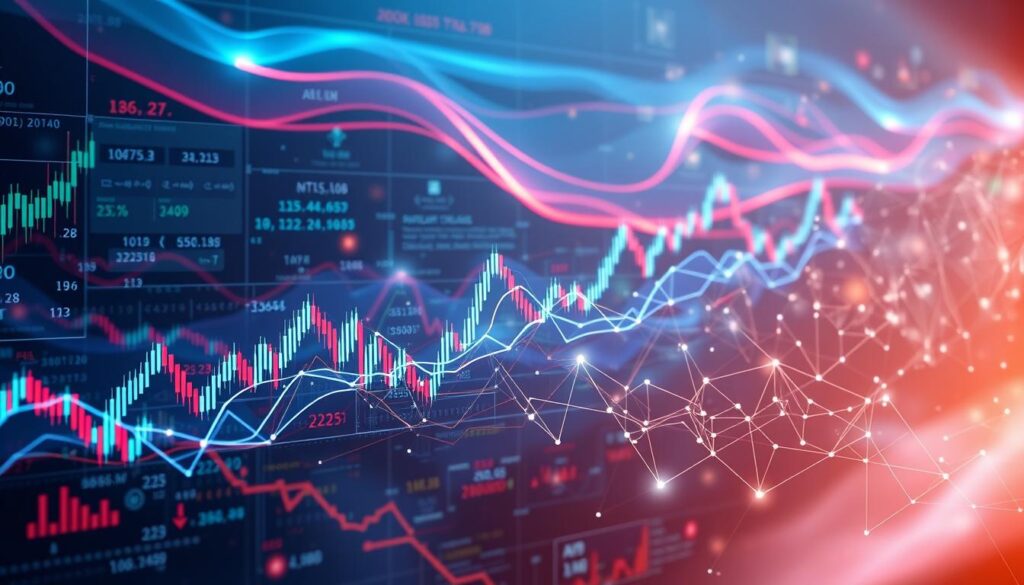Now Reading: Understanding AI Crypto Market Making Algorithm for Trading
- 01
Understanding AI Crypto Market Making Algorithm for Trading
Understanding AI Crypto Market Making Algorithm for Trading

The world of digital assets never sleeps. Markets operate across the globe, 24 hours a day. This creates a complex environment where speed and precision are paramount.
Sophisticated automated systems have emerged as a core solution. These systems process vast amounts of data in real-time. They execute trades with incredible speed, far surpassing human capabilities.
In 2023, automated trading volume surpassed $94 trillion globally. Over 70% of all trades were executed by bots. This highlights the massive shift toward technology-driven strategies.
The performance advantage is clear. Automated execution can happen in as little as 0.01 seconds. This compares to a human reaction time of 0.1 to 0.3 seconds. This speed is crucial in a fast-moving marketplace.
These systems perform vital functions. They provide liquidity, narrow price spreads, and manage risk. They operate across multiple trading venues at once, ensuring optimal trade execution.
This guide will explore how this technology tackles market challenges. We will cover everything from basic concepts to advanced implementation strategies for modern trading operations.
Key Takeaways
- Digital asset markets operate continuously, requiring fast and efficient trading solutions.
- Automated systems now execute the vast majority of global trading volume.
- The primary advantage of these systems is their incredible execution speed and data processing power.
- Key functions include providing liquidity, optimizing trade prices, and managing risk.
- This technology is essential for navigating the unique challenges of today’s trading landscape.
Introduction to AI in Crypto Trading
Modern trading environments demand solutions that can operate with unprecedented speed and accuracy. The landscape has evolved significantly from traditional methods.
Overview of AI’s Role in Modern Trading
Sophisticated systems now process millions of data points in milliseconds. They execute decisions faster than human reaction times allow.
These technologies analyze vast amounts of information continuously. They operate across multiple venues without interruption.
| Feature | Manual Approach | Automated System | Advantage |
|---|---|---|---|
| Decision Speed | 0.1-0.3 seconds | 0.01 seconds | 10x faster execution |
| Data Processing | Limited capacity | Millions of points | Comprehensive analysis |
| Operation Hours | Limited by human factors | 24/7 continuous | Never misses opportunities |
| Emotional Influence | Subject to bias | Completely objective | Consistent performance |
The Evolution from Manual to Automated Strategies
Early participants relied on intuition and basic analysis. Today’s approaches leverage advanced computational power.
The industry has professionalized significantly since 2020. Dedicated firms now deploy sophisticated methods that adapt to changing conditions.
This evolution addresses the unique demands of continuous operations. It provides competitive advantages through superior information processing.
The Basics of Crypto Market Making
Liquidity serves as the lifeblood of financial markets, enabling participants to enter and exit positions with minimal friction. Without sufficient liquidity, even simple transactions become challenging and expensive.
Understanding Liquidity Provision
Market makers act as essential intermediaries in the digital asset space. They continuously place both buy and sell orders across various price levels.
This practice creates depth in the order book. It allows other participants to execute substantial trades without causing significant price movements.
The primary revenue source comes from the bid-ask spread. This is the difference between purchase and sale prices for any given asset.
| Aspect | Traditional Markets | Crypto Environment | Impact on Strategy |
|---|---|---|---|
| Market Hours | Limited trading sessions | 24/7 continuous operation | Requires constant monitoring |
| Price Volatility | Typically under 5% daily | Often exceeds 20% daily | Demands robust risk management |
| Exchange Fragmentation | Consolidated venues | Dozens of separate platforms | Increases operational complexity |
| Regulatory Framework | Well-established rules | Evolving compliance requirements | Adds legal considerations |
Successful providers must carefully manage their inventory exposure. They avoid accumulating excessive positions in volatile assets that could suddenly decline in value.
This balancing act between liquidity provision and risk management defines professional market making. It requires sophisticated tools and constant adaptation to changing conditions.
Understanding AI Crypto Market Making Algorithm
Sophisticated automated traders function like a finely tuned engine, with several key parts working in harmony. These systems ingest vast streams of information, identify patterns, and execute decisions with incredible speed.
This continuous operation is essential for providing liquidity around the clock. The core components work together seamlessly to manage this complex task.
Key Components and Operational Mechanisms
The first layer involves a data ingestion system. It collects real-time price feeds and order book updates from multiple platforms simultaneously.
Pattern recognition modules then analyze this information. They look for short-term trends and potential arbitrage opportunities across different exchanges.
The decision-making logic is the brain of the operation. It uses pre-set rules to calculate optimal bid and ask prices. This logic aims to capture the spread while managing risk.
Risk management modules are crucial for safety. They monitor inventory levels and exposure to prevent significant losses during volatile periods.
Finally, the execution engine places orders instantly. It acts on the signals generated by the decision-making core.
| System Component | Primary Function | Advanced Feature |
|---|---|---|
| Data Feeder | Collects live market information | Processes millions of events per second |
| Analysis Core | Identifies trading signals | Uses machine learning to adapt to new patterns |
| Execution Interface | Places buy and sell orders | Connects to dozens of venues at once |
These systems learn from every trade. They analyze which actions were profitable and adjust their strategies over time. This feedback loop creates a powerful, self-improving tool for digital asset trading.
This adaptive quality separates them from basic automated tools. They evolve with the market, turning historical data into actionable insights for future success.
How AI Enhances Trading Strategies
Advanced computational methods are transforming how trading strategies are developed and executed. These systems combine multiple approaches to create more robust and adaptive solutions.

Deep Learning and Reinforcement Learning Applications
Deep neural networks process enormous volumes of historical price information. They identify complex patterns that traditional analysis might miss.
These models excel at recognizing non-linear relationships in order book data. Their pattern recognition capabilities continue to improve with more training.
Reinforcement learning agents develop optimal behaviors through trial and error. They receive rewards for profitable decisions and adjust strategies accordingly.
This approach creates systems that continuously refine their performance. Millions of simulated iterations help these agents learn effective tactics.
Sentiment Analysis using Natural Language Processing
Large language models analyze thousands of text sources to gauge market mood. They process news articles, forum discussions, and social media posts at scale.
This sentiment analysis provides early warning signals about potential price movements. The systems detect shifts in public opinion before they affect asset values.
The combination of these approaches creates comprehensive trading insights. Numerical data analysis pairs with contextual understanding for better decisions.
Research shows these machine learning models consistently outperform traditional quantitative methods. Their adaptive nature makes them particularly effective in dynamic environments.
Step-by-Step Guide to Implementing an AI Trading Bot
The journey toward automated trading excellence begins with establishing a solid foundation for your operations. Proper setup ensures your system runs smoothly and securely.
Many traders find that popular trading bots significantly improve their efficiency. These tools handle complex tasks automatically.
Setting Up Your Trading Environment
Choose between cloud-based and locally-hosted solutions based on your technical skills. Cloud options offer easier setup while local installations provide more control.
Ensure your hardware meets the system requirements. Reliable internet connection is essential for real-time operations.
| Setup Option | Technical Requirement | Best For | Security Level |
|---|---|---|---|
| Cloud-Based | Basic computer skills | Beginners | Provider dependent |
| Local Hosted | Advanced technical knowledge | Experienced traders | Full user control |
| Hybrid Solution | Intermediate skills | Balanced approach | Customizable security |
Connecting to Multiple Exchange Accounts Securely
API keys enable safe communication between your bot and exchanges. Always use limited permissions for enhanced security.
Implement two-factor authentication and regularly update credentials. Monitor activity logs to detect unusual patterns early.
These steps create a robust foundation for successful automated trading. Proper implementation prevents common technical issues.
Optimizing Trade Execution with Intelligent Algorithms
The gap between intended and actual trade prices represents a significant cost for active participants. This difference, known as slippage, can dramatically impact profitability when processing substantial orders.

Reducing Slippage and Enhancing Order Placement
Sophisticated systems break large transactions into smaller pieces executed over time. This approach minimizes price impact and avoids detection by other market players.
Smart routing distributes order fragments across multiple venues based on real-time liquidity analysis. Each exchange has unique microstructure characteristics that intelligent systems learn to exploit.
These technologies identify hidden liquidity pools not visible in public order books. They predict short-term price movements caused by substantial transactions.
Adaptive order sizing adjusts based on current market depth and conditions. Dynamic timing accelerates execution when favorable liquidity appears temporarily.
Research shows advanced execution methods reduce slippage by 10-20% compared to traditional approaches. This improvement translates directly to cost savings and enhanced returns.
Real-time adaptation allows instant responses to changing market conditions. Systems can widen spreads during volatile periods or pull orders when large trades indicate potential price swings.
Execution optimization represents a critical component of overall performance. Small percentage improvements compound significantly over thousands of transactions.
Risk Management and Adaptive Strategies in AI Trading
Successful trading operations hinge on a delicate balance between aggressive execution and prudent safeguards. The digital asset landscape’s inherent volatility makes robust protection systems essential for long-term success.
Balancing Speed with Safety
Sophisticated systems implement comprehensive frameworks that protect capital while capturing opportunities. They use position sizing algorithms that adjust exposure based on real-time volatility measurements.
Portfolio-level limits prevent overconcentration in any single asset. Real-time monitoring detects when conditions exceed safe operating parameters.
These systems automatically tighten controls during high volatility periods. They become more aggressive when favorable low-risk opportunities appear. This dynamic approach maintains performance while minimizing potential losses.
Implementing Dynamic Trade Adjustments
Specific techniques include automatic stop-loss mechanisms that exit losing positions. Maximum drawdown limits pause activity after significant losses to prevent emotional decisions.
Diversification requirements spread risk across multiple assets. Correlation analysis prevents inadvertent concentration in related positions.
Research shows reinforcement learning-based approaches experience fewer drawdowns. They achieve higher win-loss ratios than traditional rule-based systems. This indicates more effective risk management capabilities.
Dynamic adjustments include reducing position sizes during volatility spikes. Systems widen stop-loss levels to avoid premature exits during normal fluctuations. They accelerate profit-taking when momentum indicators suggest trend exhaustion.
Leveraging Machine Learning for Market Insights
Pattern recognition technologies have revolutionized how market participants extract meaningful signals from vast oceans of financial data. These systems process information that would overwhelm human analysts.
Sophisticated models identify subtle correlations and predictive patterns. They transform raw numbers into actionable intelligence for better decision-making.
Using Neural Networks for Price Predictions
Neural networks function like interconnected brain cells processing information through multiple layers. They excel at identifying complex, non-linear relationships in price movements.
Different architectures serve specific purposes in financial forecasting. Each type captures unique aspects of market behavior.
| Network Type | Primary Function | Key Advantage | Typical Application |
|---|---|---|---|
| Recurrent Neural Networks (RNNs) | Process sequential time-series data | Maintains memory of previous inputs | Price trend continuation analysis |
| Long Short-Term Memory (LSTM) | Capture long-range dependencies | Remembers important patterns over time | Multi-day trend identification |
| Convolutional Neural Networks (CNNs) | Identify spatial patterns | Recognizes chart formations | Technical pattern recognition |
These learning systems train on years of historical price movements and volume data. They recognize patterns that typically precede significant market shifts.
Predictive Analytics for Trend Identification
Predictive analytics combines statistical techniques with machine learning models. It generates probabilistic forecasts rather than single-point predictions.
This approach provides confidence intervals and probability distributions. Traders gain nuanced insights for risk-adjusted decision-making.
Practical applications include timing entry and exit points based on trend momentum. The systems also detect unusual patterns that signal emerging opportunities.
Continuous model retraining ensures predictive accuracy adapts to changing market dynamics. Performance evaluation against actual outcomes drives ongoing improvement.
Managing Market Volatility with AI Tools
Digital asset price swings present unique challenges that require sophisticated technological solutions. These systems process information faster than human capabilities allow.
Real-time data analysis techniques enable immediate response to changing conditions. Systems monitor multiple venues simultaneously across thousands of trading pairs.
Real-Time Data Analysis Techniques
Sophisticated tools employ streaming order book analysis to detect large orders before execution. They perform tick-by-tick trade monitoring to identify momentum shifts instantly.
Cross-exchange correlation analysis spots contagion effects spreading across different platforms. This comprehensive surveillance captures opportunities regardless of location.
Volatility management strategies include dynamic position sizing during turbulent periods. Adaptive stop-loss placement accounts for normal fluctuations while protecting against adverse moves.
These systems calculate real-time volatility metrics to inform decisions. They measure implied volatility from options and compare current levels to historical norms.
The ability to process market data faster than competitors provides significant advantage. Effective volatility management can mean the difference between protecting capital and suffering losses during rapid price movements.
Advanced Techniques for AI-Powered Trading
At the frontier of modern finance, computational systems operate on timescales where milliseconds determine profitability. These advanced methods analyze subtle patterns invisible to most participants.

They exploit tiny inefficiencies that appear and vanish in fractions of a second. This requires specialized infrastructure and sophisticated modeling.
Algorithmic Microstructure and High-Frequency Trading
Market microstructure analysis examines the detailed mechanics of how trades occur. It studies order book dynamics and the flow of buy and sell orders.
Intelligent systems model bid-ask bounce patterns and information asymmetry. This allows them to predict very short-term price movements with high accuracy.
High-frequency approaches execute thousands of trades daily. Positions may be held for only seconds, profiting from minute price discrepancies.
These discrepancies arise from delays in information spreading across different trading venues. Temporary liquidity imbalances also create brief opportunities.
| Strategy Type | Core Mechanism | Primary Advantage |
|---|---|---|
| Statistical Arbitrage | Exploits mean-reversion in correlated digital assets | Capitalizes on predictable relationship deviations |
| Latency Arbitrage | Capitalizes on price update delays between exchanges | Executes before prices equalize across platforms |
| Liquidity Provision | Captures bid-ask spreads while managing risk | Generates consistent revenue from market making |
For example, if Bitcoin’s price jumps on one exchange, a sophisticated bot can instantly buy on another venue. It then sells on the first exchange, locking in profit before others react.
This entire process can happen in under 0.01 seconds. This speed advantage is the cornerstone of high-frequency success in volatile environments.
Integrating AI Agents and Trading Bots
Operating multiple automated systems simultaneously presents unique coordination challenges. Sophisticated traders now integrate different bots to work together seamlessly.
This integration creates systems where specialized bots share information and avoid conflicts. A market-making bot can communicate with an arbitrage bot to prevent competition.
Trend-following bots share momentum signals that help adjust spread widths appropriately. This coordination optimizes overall portfolio performance across diverse digital assets.
Coordinating Multiple Trading Bots
Practical management approaches include unified dashboard interfaces. These provide centralized monitoring and control over all active systems.
Portfolio-level risk management aggregates exposure across all bots. Master allocation algorithms distribute capital optimally among different strategies.
The technical architecture requires message-passing protocols for real-time insights. Conflict resolution mechanisms prevent simultaneous contradictory orders.
| Coordination Method | Primary Function | Key Benefit | Implementation Complexity |
|---|---|---|---|
| Unified Dashboard | Centralized monitoring and control | Single interface management | Low to medium |
| Hierarchical Control | Supervisory agents oversee specialists | System-level adjustments | High |
| Message Protocols | Real-time information sharing | Conflict prevention | Medium |
| Capital Allocation | Dynamic fund distribution | Performance optimization | Medium to high |
Modern platforms offer strategy templates deployable across multiple assets. Performance analytics compare bot effectiveness for continuous improvement.
Successful integration requires careful planning around strategy complementarity. Effective implementation creates sophisticated operations leveraging automation at scale.
Practical Tips for Successful Crypto Trading
Building a sustainable approach to digital asset participation requires more than just following trends. Effective traders develop disciplined processes that withstand various conditions.

Learning from Backtesting and Strategy Refinement
Testing your approach against historical information reveals potential weaknesses. This process helps traders avoid costly mistakes with real funds.
Walk-forward analysis examines performance across different time periods. Out-of-sample validation ensures strategies work beyond their training data.
Key refinement practices include adjusting underperforming parameters. Eliminate complex elements that don’t improve results. Incorporate new observations from actual trading activity.
Practical steps for improvement:
- Start with small positions while learning
- Maintain detailed journals documenting decisions
- Set realistic expectations based on historical data
- Continuously study evolving digital asset dynamics
These methods help participants develop robust approaches. Consistent refinement leads to better performance over time.
Successful participation represents an ongoing educational journey. Balance confidence in proven methods with adaptability to new conditions.
Case Studies: Real-World AI Trading Success
Documented success stories provide tangible proof of enhanced performance through advanced trading methodologies. Real-world implementations showcase measurable improvements across various financial environments.
Hedge Fund Performance and Profitability Insights
Leading financial institutions report significant advantages from sophisticated approaches. Hedge funds using these technologies outperformed traditional methods by an average of 12%.
Machine-learning powered statistical arbitrage delivered 5-7% higher returns in 2024. A Sydney-based fund replaced human analysts with automated systems and consistently beat major indices.
Academic and Industry Examples
Academic research validates these approaches through rigorous testing. Reinforcement learning bots achieved higher risk-adjusted returns than traditional technical analysis.
Industry reports highlight advanced systems claiming over 80% trade success rates. Some implementations reduced execution costs by 10-20% while minimizing portfolio drawdowns.
These examples demonstrate consistent superiority across multiple performance metrics. Proper implementation delivers better outcomes for active participants.
Navigating Regulatory Challenges in AI Trading
Regulatory frameworks are rapidly evolving to address the unique challenges posed by automated systems in digital asset environments. Authorities worldwide are developing specific guidelines for testing algorithms before deployment.
This proactive approach aims to prevent erratic behavior that could destabilize financial ecosystems. Exchanges may implement specialized circuit breakers triggered by unusual automated activity patterns.
Ensuring Compliance in a Volatile Market
Current regulations impact digital asset trading through various existing frameworks. Securities laws may classify certain tokens as regulated instruments requiring specific compliance measures.
Anti-manipulation rules prohibit practices like spoofing regardless of whether humans or automated systems execute trades. Data protection regulations govern how trading systems collect and process user information.
Practical compliance strategies include maintaining robust audit trails that document all algorithmic decisions. Establishing immediate halt mechanisms during system malfunctions is equally crucial.
Human oversight remains essential, with qualified personnel understanding both technology and regulatory requirements. Regular compliance reviews help navigate the key challenges of evolving regulations.
Jurisdictional differences require careful attention. Some countries embrace innovation while others impose strict limitations, creating complex compliance landscapes for international operations.
Future Trends in AI Crypto Trading
Over the coming years, technological evolution will fundamentally reshape how participants engage with digital asset exchanges. The next 2-5 years promise deeper structural changes across financial ecosystems.
Evolving Market Dynamics and AI Advancements
Intelligent systems will proliferate, bringing enhanced liquidity to smaller digital assets. Narrow spreads may become standard even for less popular coins.
We will see algorithms interacting and adapting to each other’s patterns. Adversarial trading may emerge where one system attempts to confuse competitors.
Innovations on the Horizon
Artificial intelligence may catalyze entirely new financial instruments. These could include optimized derivatives and programmable trading venues.
The structure of digital asset markets might shift toward greater transparency. Systems demand comprehensive data to function optimally.
| Aspect | Current State | Future Outlook | Impact |
|---|---|---|---|
| Liquidity Provision | Concentrated in major coins | Widespread across assets | More uniform conditions |
| Algorithm Interaction | Limited coordination | Complex adaptive systems | Evolutionary arms race |
| Data Transparency | Fragmented across exchanges | Standardized formats | Better insights |
| Trading Products | Traditional instruments | AI-optimized derivatives | New opportunities |
These developments present both challenges and opportunities for participants. Early adopters gain advantages but face risks from untested approaches.
The broader ecosystem benefits from improved efficiency and price discovery. Continuous adaptation becomes essential for maintaining profitable strategies.
Conclusion
Successful participation in today’s financial ecosystems requires a balanced approach that leverages both technological innovation and human insight. The shift from manual methods to sophisticated automated systems represents a fundamental transformation in how trading operates.
These advanced tools deliver measurable advantages through superior execution speed, reduced transaction costs, and enhanced risk management. They process vast data streams to generate actionable insights that inform strategic decisions.
Traders should approach implementation with realistic expectations and disciplined testing. Continuous refinement based on performance data ensures strategies remain effective as conditions evolve.
The convergence of computational power and financial expertise creates ongoing opportunities for those willing to invest in education and thoughtful implementation. This represents an exciting frontier where technology augments human judgment to achieve better outcomes.
FAQ
What is the primary function of an AI-powered market making algorithm in the cryptocurrency space?
These intelligent systems are designed to provide liquidity by continuously placing buy and sell orders. They analyze vast amounts of market data to manage spreads and facilitate smoother trading, which helps reduce price volatility for various digital assets.
How do machine learning models improve trading strategies?
Learning models, such as neural networks, process historical and real-time information to identify patterns and trends. This enables the development of adaptive strategies that can adjust to changing market conditions, potentially improving trade performance and returns.
What role does sentiment analysis play in automated trading?
By applying natural language processing to sources like social media and news, these tools gauge market mood. This sentiment analysis provides valuable insights, helping algorithms anticipate short-term price movements and uncover new opportunities.
How important is risk management when using trading bots?
Effective risk management is critical. Advanced algorithms incorporate safeguards to protect capital, managing exposure and implementing dynamic adjustments. This balances the speed of executing trades with essential safety measures to navigate volatility.
Can these systems connect to multiple exchange accounts?
Yes, sophisticated platforms allow secure connections to several exchanges simultaneously. This integration enables the algorithm to access broader liquidity pools and execute trades across different markets, optimizing order placement and reducing slippage.
What are some future trends for AI in the cryptocurrency market?
The future points toward even more sophisticated learning models capable of deeper predictive analytics. We anticipate advancements in algorithmic microstructure and high-frequency trading, leading to greater efficiency and new innovations in how trades are managed.














